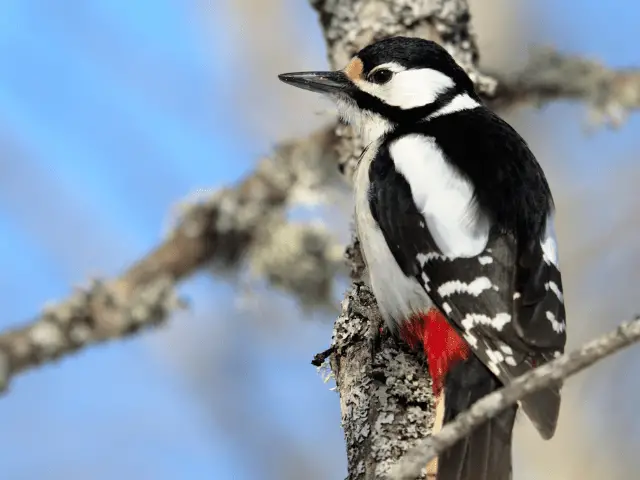If you’re traveling through the different states of America to go birdwatching...
Then...
You don’t want to miss out on the woodpeckers of Indiana.
There are countless pictures of woodpeckers in Indiana and all of them show just how beautiful their plumages are!
Out of the 255 listed woodpecker species around the world, 23 are native in the United States, and seven are normally found in Indiana.
We compiled their appearance, habitat, and diet so you may easily distinguish them when you go birdwatching, or simply feed them when they visit your backyard.
1. Downy Woodpecker
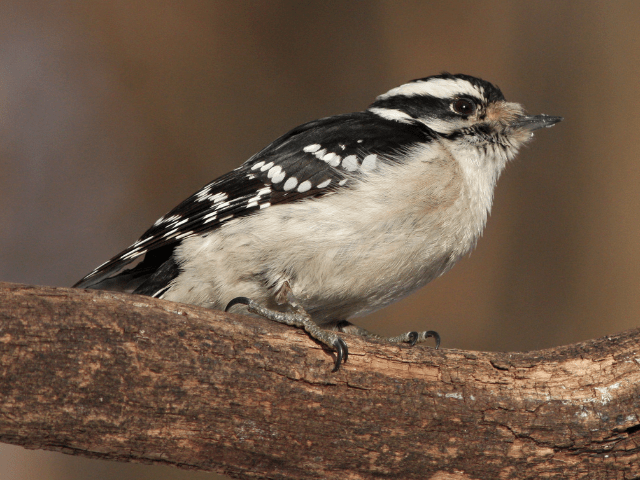
Appearance
The Downy Woodpecker is the smallest Indiana woodpecker species - measuring 5.5-6.7 inches in length, 0.7-0.1 ounces in weight, with a wingspan of 9.8-11.8 inches.
The bird’s back, rump, and wings are black, with the wings checkered by white spots. Its underparts are completely white, with a white stripe running down its back and on the upper and lower sections of both eyes.
Additionally, the male species has a red patch on its head, while the female does not.
Its bill is short and straight, while its posture is straight as well wherein it tends to lean away from the branch and rest on its tail.
Habitat
The downy woodpecker is located throughout the entirety of Indiana all year without migrating during winter.
It’s a widespread species that can be found in open woodlands, especially in deciduous trees (trees that shed leaves during autumn/winter).
However, it’s also commonly seen in parks and other residential areas. In fact, the downy woodpecker is the most likely species to visit a backyard feeder.
Diet
In the woodlands, it consumes various insects, especially ants and beetles. Seeds, berries, and nuts are part of its diet too.
In the backyard, it will eat suet from bird feeders.
2. Hairy Woodpecker
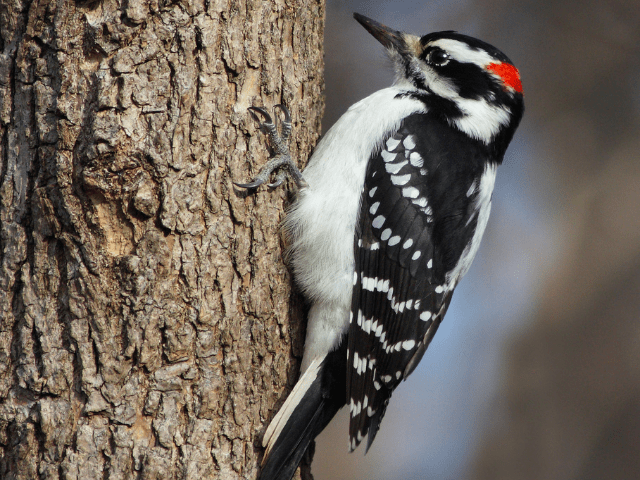
Appearance
Regarding its color scheme and posture, the hairy woodpecker (left) shares the exact appearance as the downy woodpecker (right), so you might mistake them for each other.
The differences you are looking for are body and bill size. The hairy is about a third bigger than the downy, measuring 7.1-10.2 inches in length, 1.4-3.4 ounces in weight, and 13.0-16.1 inches in wingspan.
It also has a longer bill that’s about the size of its head, while downy’s bill is about the third of its head.
Habitat
The hairy woodpecker is also seen in Indiana throughout the entire year, but not as common as the Downy.
It lives in tall trees and deep woodlands, where it tends to appear with the downy woodpecker. There’s a chance that you may see them at the same time and mistake them to be the same birds.
You may find it at backyards and parks as well, albeit minimal due to its preference for large and thick trees.
Diet
Insects are a major part of its diet, especially larvae of wood-boring beetles. It also eats seeds, berries, nuts, suet, and tree sap.
3. Northern Flicker
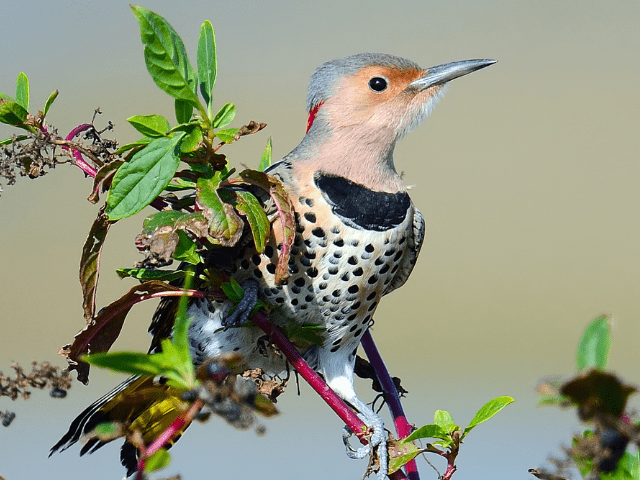
Appearance
The northern flicker is a pretty large species, measuring 11.0-12.2 inches long, 3.9-5.6 ounces heavy, with a wingspan of 16.5-20.1 inches.
Its body is dominantly brown/gray, with red patches around its beak and head. There’s also a black “bib” on its neck, and black spots all over its feathers.
However, during flight, the underside of its wings and tail have a bright yellow color. The bird also has a slightly downward-curved bill and a long, flared-out tail.
Habitat
The northern flicker can be found throughout Indiana all year round.
Just like most woodpeckers, it resides on dead trees around open woodlands. However, you will most likely find it hopping on the ground due to its feeding behavior.
This behavior also means that it doesn’t visit bird feeders often. You will have better chances of finding it on open grounds with a few trees.
Diet
This bird eats a variety of insects, fruits, seeds, and nuts, but its diet is mostly composed of ants - it probably eats more ants than other Indiana woodpeckers!
4. Pileated Woodpecker
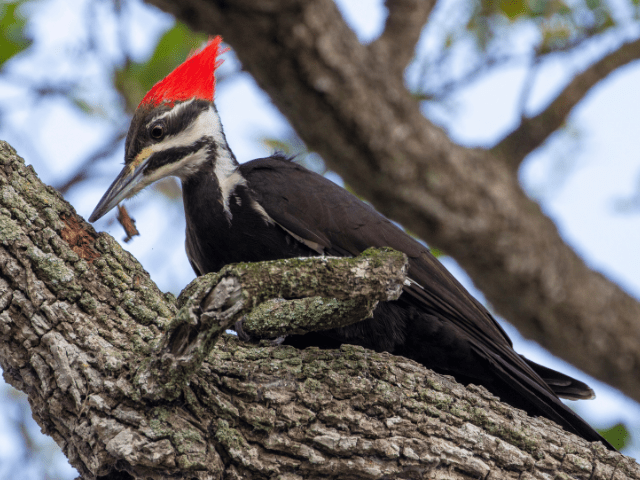
Appearance
The pileated woodpecker is the largest among the woodpeckers of Indiana, measuring around 15.8-19.3 inches long, weighing 8.8-12.3 ounces, with a wide wingspan of 26.0-29.5 inches.
Its body is mostly black with white stripes on its face and neck. Both sexes have a triangular red crest, but males have an additional red spot on each cheek. During its flight, the bird shows a large white underwing.
Habitat
The pileated woodpecker is in Indiana all year round, although it isn’t common in the northeastern part of the state.
It can be found in large forestries where there are large evergreen, deciduous, or decaying trees. A clear sign of its presence is deep excavations in wood, where it has most likely resided.
If you have a bird feeder or fallen/rotting logs in your backyard, this bird might visit you to forage or nest in them. However, it is quite difficult to attract.
Diet
This bird eats insects, fruits, nuts, and suet from bird feeders. However, Carpenter Ants make up 60% of its diet.
Unlike the northern flicker, the pileated woodpecker rarely digs into anthills for food. Instead, it whacks deep holes into rotten barks to reach ant nests.
5. Red-Bellied Woodpecker
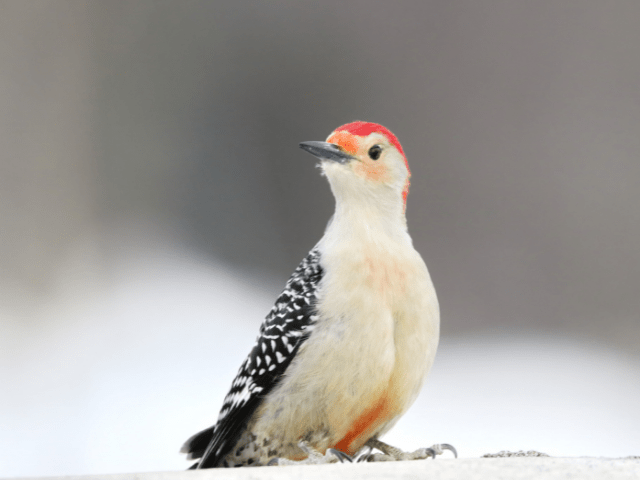
Appearance
About the same size as the Hairy Woodpecker, the red-bellied woodpecker measures 9.4 inches long, weighs 2.0-3.2 ounces, with a wingspan of 13.0-16.5 inches.
Its body is mostly cream with a subtle red shade on its belly, hence the name. It has a bright red stripe from its head to nape, and its wings are black and white with a zebra-like pattern.
Habitat
The red-bellied woodpecker can be easily found not just because of its appearance, but also its presence in Indiana all year throughout various places.
It resides in various trees, such as in coniferous and deciduous woodlands. They can also be found in medium to large suburban trees and backyard bird feeders.
Diet
This bird is omnivorous, while its diet may be more than 50% plant material (seeds, fruits, nuts) during winter. Other components of its diet include many insects, suet, lizards, sap, small fish, and even eggs from other small birds.
6. Red-Headed Woodpecker
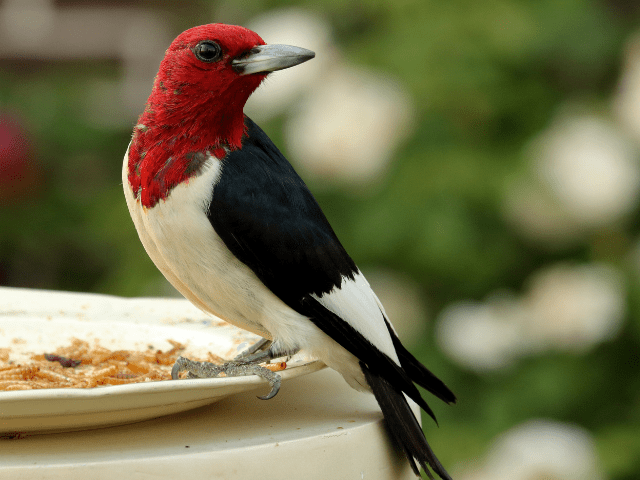
Appearance
The red-headed woodpecker is a medium-sized species that measures 7.5-9.1 inches long, weighs 2.0-3.2 ounces, and has a wingspan of 16.5 inches.
As the name suggests, the head of this woodpecker is completely red. From the neck down, its underparts are completely white, while its wings are mostly black with a huge white streak about two-thirds down.
It also has a large round head, a short and stiff tail, and a powerful straight bill.
Habitat
The red-headed Woodpecker can be found in tree cavities from scattered and open woodlands, decaying trees, pine savannas, and even agricultural areas. It may also come to bird feeders during wintertime.
Due to decreasing numbers, it’s now listed as Nearly Threatened under the IUCN Red List and placed on the State of the Birds Watch List.
Diet
Compared to other woodpeckers of Indiana, this species has a lot of foraging techniques. It also has a wide diet, wherein it consumes insects, spiders, worms, small rodents, suet, nuts, fruits, seeds, and even the tree bark itself!
It forages on trunks, branches, on the ground, and even mid-air. Sometimes, it also stores a wide variety of nuts on tree crevices to save for winter.
7. Yellow-Bellied Sapsucker

Appearance
The yellow-bellied sapsucker is fairly small but not as small as the Downy Woodpecker, measuring 7.1-8.7 inches long, 1.5-1.9 ounces heavy, with a wingspan of 13.4-15.8 inches.
This species has a bold black and white pattern on its face. The wings also have this pattern, although its defining characteristic is the downward white stripe on both sides of the wings.
Both sexes have a red forehead, but the male has a red throat as well. Its white underparts have a yellow tint, hence the name.
Habitat
This species is the most widespread sapsucker in North America. The bird is typically found in southern Indiana during the winter, then migrates into Northern Indiana and other northern states afterward.
They seldom visit bird feeders, but as long as you have birch or maple trees in your backyard, you may find a foraging Yellow-bellied Sapsucker.
Diet
As the name suggests, this bird feeds on tree sap, but also nuts, fruits, seeds, and insects. Its food preferences change based on which is most abundant in a particular season.
The yellow-bellied sapsucker acquires sap by drilling organized rows in tree trunks (called sap wells), then returning later to feed on the oozing sap. It also eats some of the tree’s tissues and the insects that are attracted to the sap.
Frequently Asked Questions
What Kind Of Woodpeckers Are In Indiana?
To recap, the seven types of woodpeckers in IN are the:
- Downy Woodpecker
- Hairy Woodpecker
- Northern Flicker
- Pileated Woodpecker
- Red-bellied Woodpecker
- Red-headed Woodpecker
- Yellow-bellied Sapsucker
Watch this clip of a Northern Flicker calling and drumming to attract females:
Frequently Asked Questions
Can You Shoot Woodpeckers In Indiana?
No, you can't. Woodpeckers are classified as migratory nongame birds, therefore protected by the Federal Migratory Bird Treaty Act. All of their species in the USA can neither be captured nor shot.
Killing or capturing woodpeckers can negatively affect the ecosystem since their activity benefits other species. For example, the cavities created by the Pileated Woodpecker and the sap wells from the Yellow-bellied Sapsucker are used by other animals for shelter and food, respectively.
If you have a woodpecker problem in your backyard, it’s better to contact wildlife professionals to effectively and legally address this issue.
What Threatens Indiana Woodpeckers?
Forest fires, urbanization, heavy rain, and heat waves are the main threats to woodpeckers. The first two conditions destroy the trees that serve as their habitat, while the latter two endanger young birds in the nest.
Conclusion
If you’re a dedicated birdwatcher who wants to see all the seven woodpeckers of Indiana, you’re in luck! They are present all year round so you can witness them anytime.
However, you need to effectively tell each species apart since some of them look alike.
Whether you want to improve your birding experience or you want to attract woodpeckers to your backyard, we hope this article provided you with sufficient information.
What’s your favorite Indiana woodpecker species? We’d love to know all about it!

